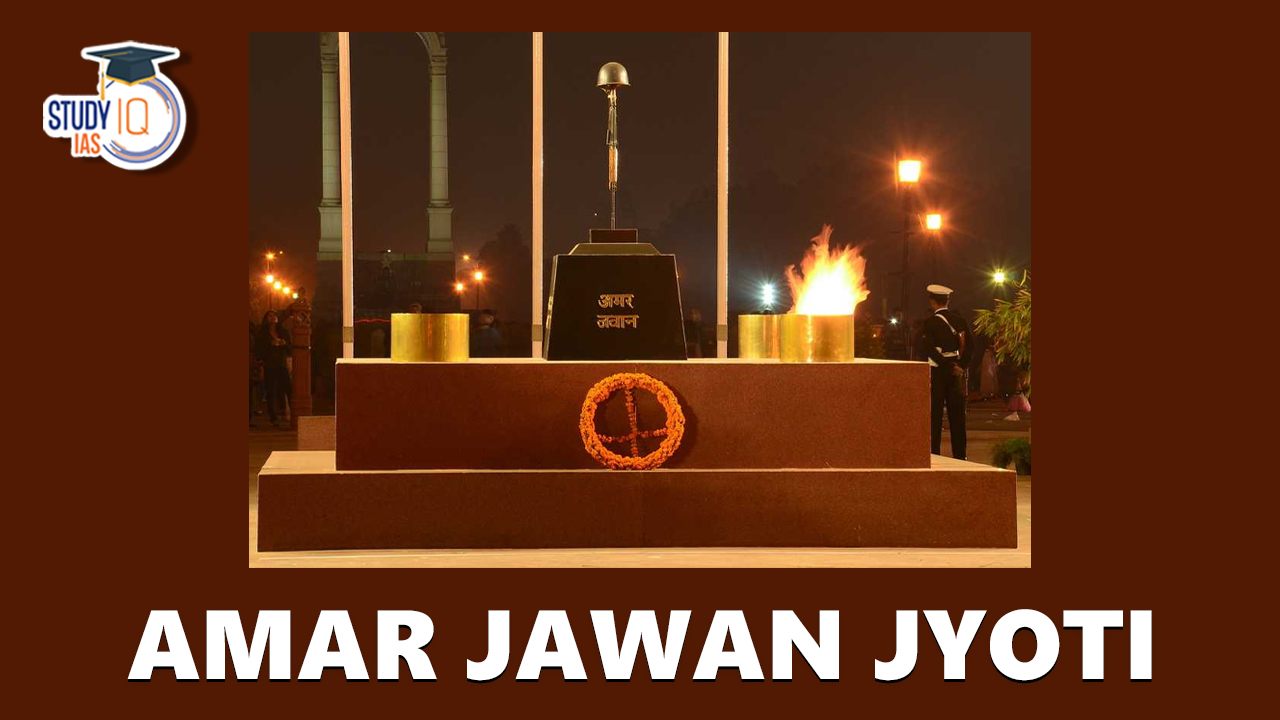Table of Contents
Amar Jawan Jyoti
An Indo-Pakistani war memorial called Amar Jawan Jyoti was created under India Gate in December 1971. After the Indo-Pakistani War of 1971, the memorial was conceptualized and unveiled on January 26, 1972. The Amar Jawan Jyoti, which was created in accordance with then-Prime Minister Indira Gandhi’s desires, serves as a memorial to the innumerable heroic lives lost during the war of 1971.
The memorial was transferred to the National War Memorial in February 2019 and combined with the new memorial there. Learn more about Amar Jawan Jyoti’s movement, history, and significance here.
Read More: Kargil Vijay Diwas
Important Facts Related to Amar Jawan Jyoti
Amar Jawan Jyoti, which means “Immortal Soldier Flame,” served as India’s national monument until February 2019. The new National War Memorial was subsequently constructed in New Delhi. The National War Memorial’s Amar Jawan Jyoti’s ancient and newer flames were combined on January 21, 2022.
On January 26, 1972, Indira Gandhi, who also gave the go-ahead for the memorial’s construction, lit the Amar Jawan Jyoti flame. Immediately following the 1971 Indo-Pakistan War, the memorial was built.
|
About Amar Jawan Jyoti |
|
| Memorial Name | Amar Jawan Jyoti |
| Established | December 1971 (India Gate) |
| Inaugurated | 26 January 1972 (India Gate) |
| Inaugurated By | Indira Gandhi (India Gate) |
| Designed By | Indian Army Corps of Engineers |
| Reallocated with | National War Memorial completed on February 2019 |
Read More: National Symbols of India
Amar Jawan Jyoti Dimensions and Structure
Amar Jawan Jyoti has a base area of 15 square feet and a height of 4 feet, three inches. A pedestal made of black marble stands 3 feet 2 inches tall on the base. On all four sides of the black pedestal are the Hindi words “Amar Javan” written in gold lettering. A reversed weapon and a battle helmet are perched atop the black pedestal. Details on Amar Jawan Jyoti has been mentioned below:
- The set-up featured 4 burners and 4 urns.
- Only one of the four burners was lighted on most days. However, the Amar Javan’s four burners were ignited on significant days like Republic Day.
- These burners were referred to as the perpetual flame, and it was never permitted to be put out.
- The Military Engineering Services were in charge of maintaining the Amar Jawan Jyoti flame.
History of Amar Jawan Jyoti
After the 1971 Indo-Pakistani War, Amar Jawan Jyoti was erected beneath India Gate. The conflict, which was a part of the liberation struggle in East Pakistan, lasted from December 3, 1971, to December 16, when Dhaka fell. Prime Minister Indira Gandhi formally unveiled the monument on January 26, 1972, the 23rd Republic Day of India. From 1971 to 2006, cylinders of liquefied petroleum gas (LPG) were used to power the Amar Jawan Jyoti’s flame. Here are some further details regarding the urn’s lighting:
- The Military Engineering Services took care of lighting the Amar Jawan Jyoti flame.
- One urn of the Amar Javan could be fueled by a single LPG cylinder for roughly 36 hours.
- LPG cylinders were replaced in December 2005 with the help of Piped Natural Gas (PNG), a safer and more cost-effective alternative.
Reallocation of Amar Jawan Jyoti to National War Memorial
The Amar Jawan Jyoti is currently reallocated at National War Memorial’s inner ring, the Amar Chakra (Circle of Immortality). In February 2019, it was transferred from India Gate to the National War Memorial. Later, the Amar Jawan Jyoti light and the new flame at the National War Memorial were formally combined.
It has been usual for the Prime Minister of India, three service chiefs, and dignitaries to lay a wreath here on January 26th ever since the Amar Jawan Jyoti was established in 1972. The nation as a whole pays tribute to the martyrs and the troops who gave their life during the liberation war in East Pakistan through the Amar Jawan Jyoti.
National War Memorial
It opened in 2019 and is 400 meters away from India Gate. Four concentric circles make up the structure’s design which is named as.
- “Amar Chakra” or Circle of Immortality,
- “Veerta Chakra” or Circle of Bravery,
- “Tyag Chakra” or Circle of Sacrifice and
- “Rakshak Chakra” or Circle of Protection.
In the 1960s, the idea for a national war memorial was originally floated. The memorial honours those who gave their lives protecting the country in the Sino-Indian War of 1962, the Indo-Pak Wars of 1947, 1965, and 1971, the operations of the Indian Peace Keeping Force in Sri Lanka, and the Kargil Conflict of 1999. The National War Memorial also honours the troops who took part in and gave the ultimate sacrifice during HADR (Humanitarian Assistance for Disaster Relief) operations, counterinsurgency operations, and Low-Intensity Conflict Operations (LICO) for the United Nations.


 UPSC CMS Admit Card 2025 Out: Download L...
UPSC CMS Admit Card 2025 Out: Download L...
 UPSC Study Material for Prelims & Ma...
UPSC Study Material for Prelims & Ma...
 NATO Countries List 2025, Members, Funct...
NATO Countries List 2025, Members, Funct...





















